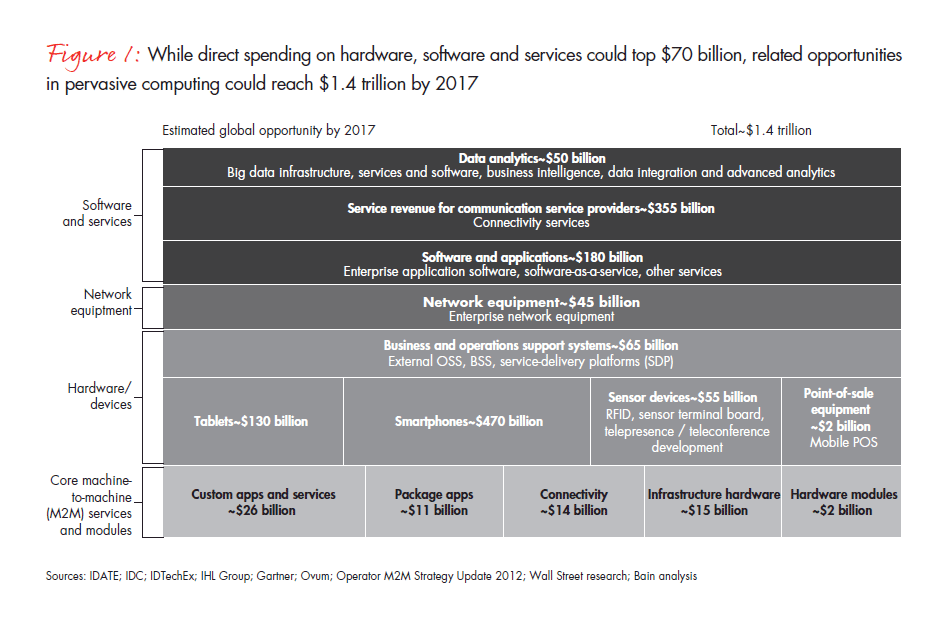Brief

Intelligent cars that drive and park themselves. Retail systems that watch where shoppers linger. Home thermostats that detect the owner’s arrival and turn up the heat. In some ways, the future is already here: each of these applications is already up and running, a part of the Internet of Things. What’s changing quickly is the universality of them, the integration and communication among systems like these to create a new paradigm of pervasive computing.
Which companies will provide the hardware, software and services that make these scenarios extensive and real? If the past is an indicator, they may not be the same companies providing them today. We see pervasive computing as a major architectural shift. As in previous shifts, we expect to see the leaderboard reshuffled. The winners in pervasive computing will develop high-value, repeatable solutions at the intersection of mobility, analytics and cloud computing, creating new sources of value from the explosion of data that surrounds us.
All of this activity will generate tremendous opportunity across many industries. Direct investment in hardware, software and solutions could top $70 billion by 2017, and the related opportunities are much greater—perhaps as much as $1.4 trillion (see Figure 1). Google’s purchase of Nest for $3.2 billion in January 2014 indicates some of the enthusiasm for connected products and services that appeal to customers.

Some industries are already using pervasive computing at scale. Utilities are investing significantly in smart grids, smart meters and smart thermostats, encouraged by regulators and enabled by established standards. In healthcare, on the other hand, privacy concerns and industry fragmentation create barriers to unlocking new value from pervasive computing solutions.
As with other architectural shifts, we expect the first comprehensive solutions to be designed for specific industries. That focus will allow developers and designers to work within a limited construct of requirements to solve the complex problems of association and management across multiple layers and thousands of devices. Many components already exist, but the cost and complexity of integrating them into a complete solution remains expensive. Companies that can create affordable, end-to-end offerings will make it easier for others to invest in the next wave of computing. Over time, we’ll see platforms emerge within sectors, followed by cross-industry solutions.
As these platforms emerge, the companies creating pervasive computing solutions will need to overcome several hurdles. At the infrastructure and database layers, they will need to learn how to manage the interaction of millions of sensors and find ways to cost-effectively collect and analyze the huge volumes of unstructured data they produce. In development, new platforms geared specifically for machine-to-machine applications, like Salesforce1 and GE’s Predix, are just beginning to scale up.
All of these issues will lead to rich discussions as senior executives plan their pervasive computing strategies. Among the questions they should be asking:
- Where does the value lie: in hardware (advanced servers, new chips), in software and services, or in the data itself?
- Which solutions will meet customer needs and offer a compelling case for investment? Which will reduce costs, generate revenue and lower risk?
- What capabilities and assets do we need to develop and deliver these solutions? Who should we partner with, up or down the stack?
- Which standards should we back?
- What are the risks of not acting?
The next three to five years will be critical as pervasive computing moves into the mainstream and the number of connected devices and related applications skyrockets. Executives across industries, but especially in the technology industries that will enable this shift, should focus on answering the critical questions today that will position them for leadership tomorrow.
Chris Brahm and Travis Pearson are partners with Bain & Company in San Francisco. Mark Brinda is a Bain partner in New York, and Velu Sinha is a partner in Bain’s Palo Alto office. All four work with the firm’s Technology practice in North America, which Travis leads.
